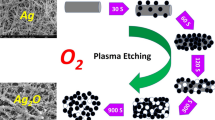Abstract
We have used constant-current, metal-assisted electrochemical etching of silicon in HF/H2O2/ethanol electrolyte to fabricate porous silicon. We found that, at large enough current density, the sponge-like porous silicon structure is replaced by a mosaic structure, which includes islands of various shapes emerging between trenches that have been etched downward. Energy-dispersive x-ray analysis showed that the surface of the mosaic pieces was covered with silicon oxide, while little silicon oxide developed on the surface of trenches. We suggest that the appearance of the mosaic structure can be explained by the increase in the oxidation rate of silicon when the anodic current density increases, combined with no change in the dissolution rate of silicon oxide into the solution. Consequently, above a certain value of anodic current density, there is sufficient residual silicon oxide on the etched surface to create a continuous thin film. However, if the silicon oxide layer is too thick (e.g., due to too high anodic current density or too long etching time), it will become cracked (formation of mosaic pieces), likely due to differences in thermal expansion coefficient between the amorphous silicon oxide layer and crystalline silicon substrate. The oxide is cracked at locations with many defects, and the cracks reveal the silicon substrate. Therefore, at the locations where cracks occur, etching will go sideways and downward, creating trenches.
Similar content being viewed by others
References
L.T. Canham, Appl. Phys. Lett. 57, 1046 (1990).
X. Zhang, L. He, W. Wang, and X. Zhang, J. Vac. Sci. Technol. B 33, 031211 (2015).
C.H. Lin, S.C. Lee, and Y.F. Chen, J. Appl. Phys. 75, 7728 (1994).
J.L. Gole, J.A. DeVincentis, and L. Seals, Phys. Rev. B 61, 5615 (2000).
Y. Zhao, D. Li, S. Xing, W. Sang, D. Yang, and M. Jiang, Solid State Commun. 143, 197 (2007).
M.B. Prigozhin, P. Shiwsankar, W.R. Algar, and U.J. Krull, Proc. SPIE 7099, 70991A-1 (2008).
K.B. Tynyshtykbaev, YuA Ryabikin, SZh Tokmoldin, T. Aitmukan, B.A. Rakhymetov, and R.B. Vermenichev, Tech. Phys. Lett. 36, 538 (2010).
K.B. Tynyshtykbaev, Yu.A Ryabikin, K.A. Mit’, B.A. Rakymetov, and T. Aitmukan, Phys. Solid State 53, 1575 (2011).
H. Kim and N. Cho, Nanoscale Res. Lett. 7, 408 (2012).
D.T. Cao, L.T.Q. Ngan, and C.T. Anh, Surf. Interface Anal. 45, 762 (2013).
X. Lu, Y. Ishida, and T. Yonezawa, New J. Chem. 39, 6267 (2015).
S.M. Faraj, S.M.A. Al-Baqi, N.R. Jber, and J. Fisher, J. Nanotechnol. Eng. Med. 6, 011003 (2015).
K.B. Tynyshtykbaev, T. Aitmukan, A.T. Issova, B.A. Rakhymetov, M.A. Yeleuov, and SZh Tokmoldin, Mater. Sci. Appl. 4, 1 (2013).
X. Li and P.W. Bohn, Appl. Phys. Lett. 77, 2572 (2000).
X.G. Zhang, J. Electrochem. Soc. 151, C69 (2004).
S.M. Allameh, Advanced Structural Materials: Properties, Design Optimization, and Applications, ed. W.O. Soboyejo and T.S. Srivatsan (Moko: CRC Press, 2007), p. 68.
Acknowledgements
This work was financially supported by the Vietnam National Foundation for Science and Technology Development (NAFOSTED) under Project 103.02-2013.42.
Author information
Authors and Affiliations
Corresponding author
Rights and permissions
About this article
Cite this article
Cao, D.T., Anh, C.T. & Ngan, L.T.Q. Formation of Mosaic Silicon Oxide Structure during Metal-Assisted Electrochemical Etching of Silicon at High Current Density. J. Electron. Mater. 45, 2615–2620 (2016). https://doi.org/10.1007/s11664-016-4434-4
Received:
Accepted:
Published:
Issue Date:
DOI: https://doi.org/10.1007/s11664-016-4434-4




